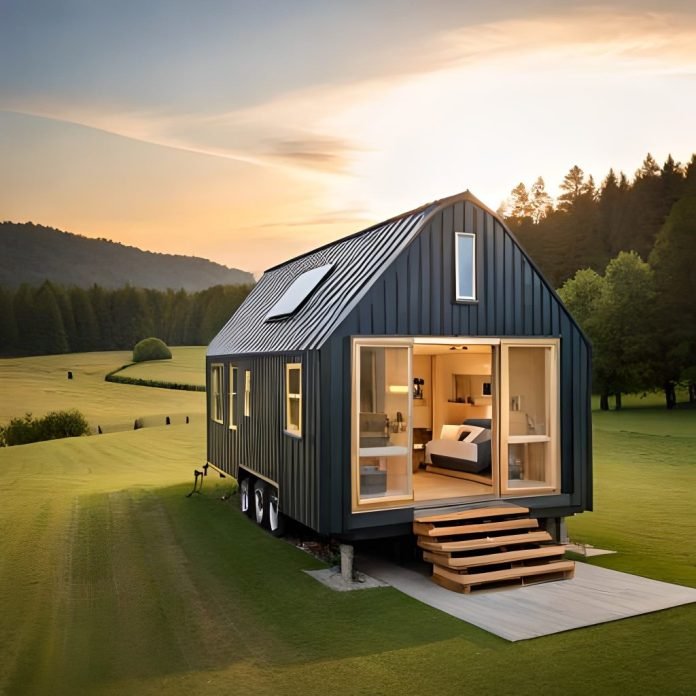Last Updated on April 24, 2023 by
Table of Contents
Introduction
In recent years, the tiny house movement has gained significant traction as people search for simpler, more sustainable lifestyles. One development in this movement is incorporating solar power, allowing homeowners to live off-grid and reduce their carbon footprint. This article will explore the benefits of solar-powered tiny homes, discuss how to build one, and share some real-life examples.
2. Benefits of Solar-Powered Tiny Homes
2.1. Environmental Impact
Solar-powered tiny homes drastically reduce their reliance on fossil fuels by harnessing the sun’s energy, resulting in lower greenhouse gas emissions. This renewable energy source helps to combat climate change and promote a cleaner, greener future.
2.2. Financial Savings
Solar-powered tiny homes offer significant financial savings in the long run. With initial solar panels and equipment investment, homeowners can reduce or eliminate monthly energy bills. Furthermore, tiny homes typically cost less to build and maintain, making them an attractive option for those looking to minimize expenses.
2.3. Simplified Living
Living in a solar-powered tiny home encourages a minimalist lifestyle, which can lead to less stress and more fulfillment. By downsizing possessions and living space, homeowners can focus on what truly matters and enjoy a simpler, more intentional way of life.
2.4. Off-Grid Capabilities
One of the most appealing aspects of solar-powered tiny homes is their ability to function off-grid. This allows homeowners to live in remote locations, travel with their homes, and maintain self-sufficiency during power outages or emergencies.
3. How to Build a Solar-Powered Tiny Home
3.1. Planning and Design
Careful planning and design is the first step in building a solar-powered tiny home. This includes selecting a suitable location, determining the size and layout of the home, and considering energy needs and storage options. Ensuring that the design can accommodate solar panels and equipment without compromising living space is essential.
3.2. Choosing the Right Solar System
Selecting the appropriate solar system for your tiny home is crucial. Factors to consider include sunlight availability, energy consumption needs, and budget. A qualified solar installer can help determine the best system for your requirements.
3.3. Installation and Maintenance
Once the solar system has been selected, it must be properly installed and maintained to ensure optimal performance. This may involve hiring a professional installer or completing the installation yourself. Regular maintenance, such as cleaning panels and monitoring performance, will help maximize the system’s efficiency and lifespan.
4. Real-Life Examples of Solar-Powered Tiny Homes

Numerous solar-powered tiny homes have been built around the world, demonstrating the potential of this sustainable living solution. Here are a few inspiring examples:
- The Tiny Solar House: This tiny mobile home features a 1.65 kW solar system, allowing its owner to travel across the United States while living off-grid. The home includes a sleeping loft, kitchen, and bathroom, proving that sustainable living can be comfortable and stylish.
- The Sol Haus: Designed by Vina Lustado, the Sol Haus is a 140-square-foot tiny home powered by a 1.2 kW solar array. The energy-efficient design features passive solar heating and cooling and has been recognized for its exceptional sustainability and aesthetics.
- The Greenmoxie Tiny House: This off-grid tiny home has a 1 kW solar array and a rainwater catchment system. The Greenmoxie incorporates reclaimed materials and a green roof, showcasing how solar power can be integrated into a holistic approach to sustainable living.
Conclusion
Solar-powered tiny homes offer an appealing solution for those seeking a more sustainable, simplified lifestyle. By harnessing the sun’s power, homeowners can minimize their environmental impact, save on energy costs, and enjoy the freedom of off-grid living. Building a solar-powered tiny home requires careful planning, selecting the right solar system, and proper installation and maintenance. With numerous real-life examples demonstrating the potential of these eco-friendly dwellings, it’s clear that solar-powered tiny homes are a viable option for a brighter, greener future.
Apart from that, if you are interested to know about The Benefits of Using Powerful Solar Lights then visit our Technology category.
FAQs
The cost of a solar-powered tiny home varies depending on factors such as size, design, and solar system specifications. On average, expect to spend between $30,000 and $60,000 for a tiny home, plus the cost of the solar system, which can range from $5,000 to $20,000.
The space required for solar panels depends on the size and output of the solar system. Generally, a 1 kW solar system requires about 65-100 square feet of space. Consult a solar professional to determine the appropriate system size and space requirements for your specific needs.
Building a solar-powered tiny home yourself is possible but requires careful planning, research, and construction skills. If you choose to go the DIY route, be prepared to invest time and effort into learning about solar systems, small home design, and construction techniques.
Solar-powered tiny homes can be adapted to various climates, but their effectiveness will depend on sunlight availability and insulation. Additional energy sources or larger solar systems may be necessary in areas with limited sunlight. Proper insulation and design are essential for maintaining comfort in extreme temperatures.
Solar panels typically have a 25-30 years lifespan, with their efficiency gradually decreasing over time. Regular maintenance and monitoring can help maximize the performance and longevity of the solar system.



























